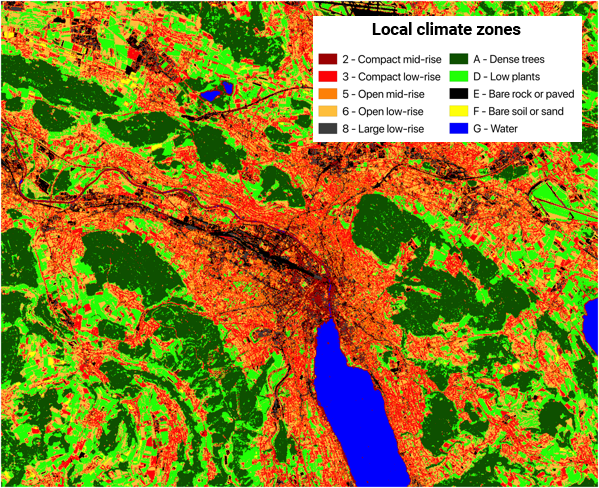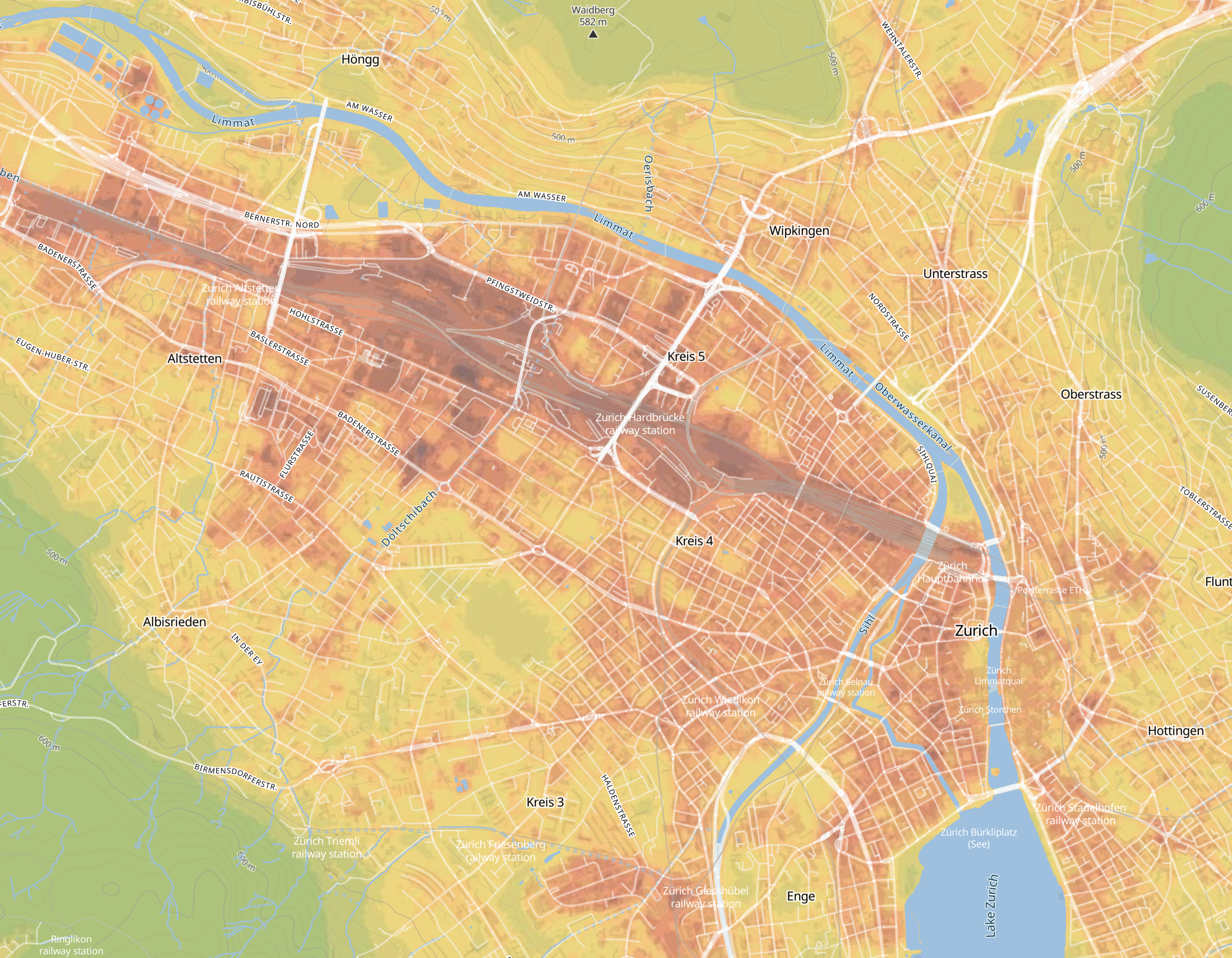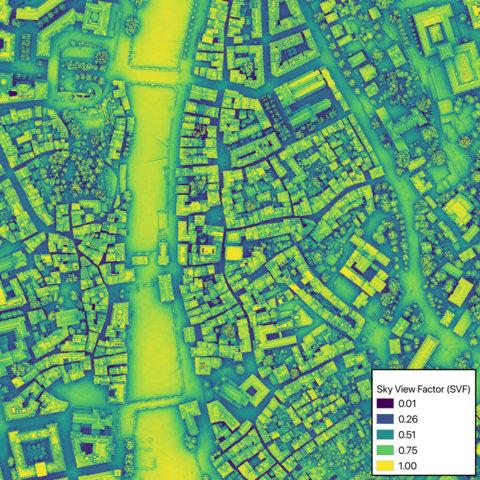- Top precision: Scientific verification of our unique city climate model conducted over 3 years shows a model error below 1°C for temperatures calculated between weather stations. Our 24h air temperature forecast has the accuracy of 1.2 K, effectively providing the most precise forecast possible for any city location.
- Artificial intelligence: The meteoblue City Climate Monitoring system uses proprietary artificial intelligence to combine in-situ meteorological measurements with satellite data and numerical forecast models to produce precise data with a minimum of sensors, and in the most economical way.
- Seamlessly from history to forecast: We offer historical data, real-time updates and a 7-day forecast for any location within a city. Additionally, we use climate projections to estimate the air temperature and precipitation for different future time horizons (e.g., until 2050) pertaining to different emission scenarios.
- High resolution: Our city climate models have a horizontal resolution of 10m, and resolve the entire micro-scale variability of air temperature and wind velocity fields, bringing precise weather information to each doorstep.
- Multiple meteorological variables: We offer measurements of multiple meteorological variables (air temperature, relative humidity, precipitation) and provide modelled wind speed and direction at high spatial resolution for a wide range of applications.
- Multiple interfaces: Our products are available via API, FTP server, web, and app, offering you easy plug & play access to all possible applications.
Variables & Use Cases
- Urban heat islands and their impact on people with health issues
- Temperature estimates and their application in urban planning
- Flood monitoring and winter season planning
- The role of wind flows in city planning
- Air quality prediction and applications
Temperature
The modelled air temperature can be used for monitoring urban heat islands, for determining their extent, and for warning residents of great heat stress in certain areas of the city. These warnings are particularly relevant for people with health risks, elderly people, or pregnant women.
Air temperature estimates can additionally be used by urban planning institutions and architectural companies for a climate-friendly design of new areas, reconstructions of parks, squares, and buildings in order to achieve the optimal solution for the population in the city.
Wind Speed and Direction
To cool down the urban area during summer, it is key to retain cool air channels, devoid of buildings which would block the airflow. To detect the cold air corridors, wind flows and wind fields are estimated from modelled wind data.
The data can also be used for tracking particulate matter and air pollution in general, and to differentiate areas of relief or concern. Accurate data of wind flows are useful also when issuing more precise warnings in the event of fire and smoke.
In spring and summer, it is important to predict pollen count precisely within complex urban areas in order to notify individuals who suffer from allergies.
Precipitation
Precipitation can vary greatly even within small areas. Monitoring is therefore important. In case of heavy rain events, flooding estimates require determining the exact location of the heavy precipitation, both for planning and for evacuation. Modelled precipitation data allows planners and insurers to easily check weather related insurance reports for credibility.
In winter, it is useful to know where and how much snow to expect. Municipal utilities are thus enabled to better plan road salt stocks for the winter season, based on the provided data.
What is a "Local Climate Zone"?
meteoblue provides local climate zone maps for any city in the world. A climate zone map is generated from satellite images with a horizontal resolution of 10m, using proprietary ground-truthing algorithms. Local climate zone (LCZ) information is the basis for sensor placement, for statistical analysis, and for model validation and enhancement.
LCZs are a means to classify surface types that affect the local climate differently. 10 LCZ types (1-10) describe built-up areas in terms of building types and spatial arrangements, materials, human activities, plants, ground surface properties, etc.
7 more types (A-G) describe land cover in terms of plant cover and ground surface properties. The definitions of LCZ were introduced in Stewart, I.D. and Oke, T.R. 2012. Local Climate Zones for urban temperature studies.


— Bulletin of the American Meteorological Society, 93: 1879-1900.
- Compact high-rise: LCZ 1 is characterised by a dense mix of tall buildings (more than 10 floors) with concrete, steel, stone, and glass construction materials. There is little or no vegetation and the surface is mostly paved.
- Compact midrise: LCZ 2 is characterised by a dense mix of midrise buildings (3-9 floors) with concrete, steel, stone, and glass construction materials. There is little or no vegetation and the surface is mostly paved.
- Compact low-rise: LCZ 3 is characterised by a dense mix of low-rise buildings (1-3 floors) with concrete, steel, stone, and glass construction materials. There is little or no vegetation and the surface is mostly paved.
- Open high-rise: LCZ 4 is characterised by an open arrangement of tall buildings (more than 10 floors) with concrete, steel, stone, and glass construction materials. Low plants and scattered trees create a permeable landcover.
- Open midrise: LCZ 5 is characterised by an open arrangement of midrise buildings (3-9 floors) with concrete, steel, stone, and glass construction materials. Low plants and scattered trees create a permeable landcover.
- Open low-rise: LCZ 6 is characterised by an open arrangement of low-rise buildings (1-3 floors) with concrete, steel, stone, and glass construction materials. Low plants and scattered trees create a permeable landcover.
- Lightweight low-rise: LCZ 7 is characterised by a dense mix of single-story buildings with lightweight construction materials like wood, thatch and corrugated metal. There is little or no vegetation and the surface is mostly hard-packed.
- Large low-rise: LCZ 8 is characterised by an open arrangement of large low-rise buildings (1-3 floors) with concrete, steel, stone, and metal construction materials. There is little or no vegetation and the surface is mostly paved.
- Sparsely built: LCZ 9 is characterised by a sparse arrangement of small or medium-sized buildings in a natural setting. Low plants and scattered trees create a permeable landcover.
- Heavy industry: LCZ 10 is characterised by low-rise and midrise industrial structures like towers, tanks and stacks with metal, steel and concrete construction materials. There is little or no vegetation and the surface is mostly paved or hard-packed.
- Dense trees: LCZ A is characterised by deciduous and/or evergreen tree. It is a heavily wooded landscape and the landcover is mostly permeable. The zone functions as natural forest, tree cultivation or urban park.
- Scattered trees: LCZ B is characterised by deciduous and/or evergreen tree. It is a lightly wooded landscape and the landcover is mostly permeable. The zone functions as natural forest, tree cultivation or urban park.
- Bush, scrub: LCZ C is characterised by an open arrangement of bushes, shrubs and short, woody trees. The landcover is mostly permeable with bare soil or sand. The zone functions as natural scrubland or agriculture.
- Low plants: LCZ D is characterised by a featureless landscape of grass or herbaceous plants or crops. There is little or no trees. The zone functions as natural grassland, agriculture, or urban park.
- Bare rock or paved: LCZ E is characterised by a featureless landscape of rock or paved cover. There is little or no vegetation. The zone functions as natural desert (rock) or urban transportation.
- Bare soil or sand: LCZ F is characterised by a featureless landscape of soil or sand cover. There is often little or no vegetation. The zone functions as natural desert or agriculture.
- Water: LCZ G is characterised by large, open water bodies such as seas and lakes, or small bodies such as rivers, reservoirs, and lagoons.
Scientific Documentation

Small scale modelling of meteorological variables
meteoblue calculates small-scale meteorological variable fields for cities with the horizontal resolution of 10m for each measurement time step of 15 minutes. The meteoblue city climate models interpolate locations between sensor locations with special techniques utilising data from satellites, as well as digital surface and elevation models.
Air temperature, precipitation, wind speed and wind direction are assessed for any location in the city, bringing weather information to the inhabitants' doorsteps. Based on the small-scale air temperature field, urban heat islands are detected, as well as cold inflows.
In addition, flood and hail warnings for the city can be created on the basis of high-resolution precipitation data. Air pollution is assessed automatically by combining local air pollution data sources with a three-dimensional wind field calculation.

High computational power from the cluster
meteoblue runs city climate models on a very fine horizontal resolution down to 0.5 m (see the sky view factor figure on the left). The sky view factor expresses the proportion of sky visible from a point on a surface. Street canyons or areas covered by trees have a low sky view factor in contrast to the high sky view factor of open places and building rooftops.
The model calculations require substantial computational power. Historical data, nowcast, 7-day forecast as well as climate projections are all calculated for any point in the city and available from the meteoblue databases.

High accuracy of city climate models
The meteoblue city climate models achieves unique accuracy with errors below 1°C (hourly MAE) with the spatial interpolation technique, with a decreasing error when using more stations.
We are also able to calculate the number of stations needed to achieve the desired accuracy of modelled data. Based on our existing verification studies, for our 24h forecast an accuracy of 1.2 °C hourly MAE for air temperature can be expected, based on our existing verifications.



